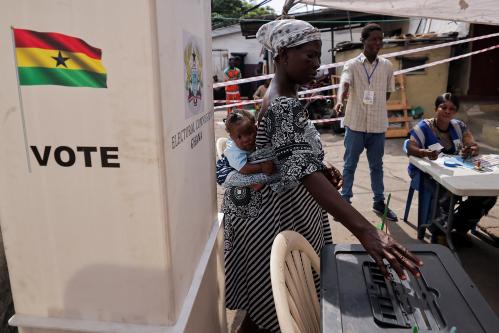On October 19, the World Bank published Accelerating Poverty Reduction in Africa, which delves into the challenges and opportunities in tackling Africa’s poverty. The report finds that, despite significant recent reductions in poverty, many African countries still have many of the highest poverty rates in the world.
As noted in the report, poverty is not distributed equally across Africa. Three-quarters of Africa’s poor live in 10 countries: Nigeria (which is actually 25 percent on its own), the Democratic Republic of the Congo (DRC), Tanzania, Ethiopia, Madagascar, Mozambique, Uganda, Malawi, Kenya, and Zambia. Figure 1 shows this distribution: Poverty rates are particularly high in the DRC and central Africa, northern Nigeria and the Sahel, Madagascar, and Mozambique, while several regions of Ethiopia have strikingly high numbers of the extremely poor. Notably, there is limited correspondence between areas with high poverty rates and areas with high numbers of the extremely poor, which may pose a policy challenge. According to the report, targeting areas with the largest numbers—not rates—of poverty can yield faster overall poverty reduction. At the same time, people living in areas with high poverty rates are likely to have more difficulty escaping poverty, and to live in “poverty traps.” The report states that conflict can spread from areas with these “poverty traps,” potentially reversing the gains made from targeting areas with large numbers of the extremely poor.
Figure 1: Concentration of poverty in Africa by country and region
 Source: Accelerating Poverty Reduction in Africa
Source: Accelerating Poverty Reduction in Africa
Figure 2 shows that falling back into poverty is not uncommon in Africa. On the continent, the share of poor people who move out of poverty, known as the upwardly mobile, is currently about the same as the share of the nonpoor who fall into poverty, or downwardly mobile. In Uganda, for example, for every three people who moved out of poverty from 2006 to 2013, two people fell back into poverty. The report states that it is critical to reduce shocks and volatility, such as ill health, drought, price shocks, and conflict, that reverse gains and limit progress in order to reduce poverty over the long term.
Figure 2: Movement into and out of poverty
 Source: Accelerating Poverty Reduction in Africa
Source: Accelerating Poverty Reduction in Africa
To reduce poverty and address the issue of downward mobility specifically, the report recommends interventions that can be used to help households reduce their exposure to or better manage shocks. These programs include relatively low-cost interventions to reduce health risks through malaria prevention, improved water and sanitation, and increased immunizations; to manage climate and weather risks through irrigation, improved land management, and improved seeds; and to increase savings and insurance rates. These interventions will require households and governments to act before shocks occur, and to plan for the future, rather than focusing on the present.
For a critical take on Accelerating Poverty Reduction in Africa, see Louise Fox’s post, “Assessing past and future strategies for reducing poverty in Africa.”
The Brookings Institution is committed to quality, independence, and impact.
We are supported by a diverse array of funders. In line with our values and policies, each Brookings publication represents the sole views of its author(s).




Commentary
Figure of the week: Accelerating poverty reduction in Africa
October 24, 2019